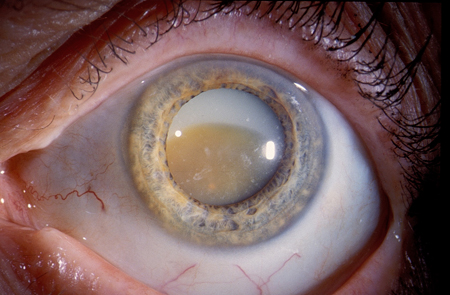Resumo
Definição
História e exame físico
Principais fatores diagnósticos
- presença de fatores de risco
- redução subjetiva da visão
- visão turva ou embaçada
- ofuscamento
- visão de cores desbotadas
- acuidade visual reduzida
- reflexo vermelho embotado
Outros fatores diagnósticos
- prescrição inadequada de óculos de grau
- interrupção das atividades da vida diária
Fatores de risco
- idade >60 anos
- sexo feminino
- tabagismo
- exposição à ultravioleta (UV) em longo prazo
- diabetes mellitus
- trauma ocular
- uso de corticosteroides em longo prazo
- história familiar de catarata congênita ou influências congênitas (por exemplo, toxinas)
- uveíte
- miopia
- outras afecções metabólicas ou hereditárias
- exposição a radiação ionizante
- índice de massa corporal (IMC) alto
Investigações diagnósticas
Primeiras investigações a serem solicitadas
- exame do fundo do olho com dilatação
- medição da pressão intraocular
- exame de ofuscamento da visão
- exame da câmara anterior com lâmpada de fenda
Investigações a serem consideradas
- avaliação do melhor potencial visual
- ultrassonografia modo B
Algoritmo de tratamento
catarata sem patologia ocular concomitante
catarata com patologia ocular concomitante
opacificação pós-cirúrgica da cápsula posterior + comprometimento visual significativo
Colaboradores
Autores
Robert T. Chang, MD
Associate Professor of Ophthalmology
Byers Eye Institute
Stanford University School of Medicine
Stanford
CA
Declarações
RTC declares that he is a consultant for Alcon, AbbVie, and Zeiss.
Agradecimentos
Dr Robert T. Chang would like to gratefully acknowledge Dr Creig Hoyt, Dr Leela V. Raju, and Dr M. Bowes Hamill, previous contributors to this topic.
Declarações
CH, LVR, and MBH declare that they have no competing interests.
Revisores
Michael P. Ehrenhaus, MD
Assistant Professor of Ophthalmology
Cornea External Disease and Refractive Surgery Local Director
Long Island College Hospital Eye Center
Brooklyn
NY
Declarações
MPE declares that he has no competing interests.
Parwez Hossain, PhD, FRC Ophth, FRCS(Ed)
Associate Professor/Consultant in Ophthalmology
University of Southampton
Southampton
UK
Declarações
PH declares that he has no competing interests.
Bob Avery, MD, PhD
Assistant Professor
Ophthalmology
University of New Mexico Medical School
Albuquerque
NM
Declarações
BA declares that he has no competing interests.
Créditos aos pareceristas
Os tópicos do BMJ Best Practice são constantemente atualizados, seguindo os desenvolvimentos das evidências e das diretrizes. Os pareceristas aqui listados revisaram o conteúdo pelo menos uma vez durante a história do tópico.
Declarações
As afiliações e declarações dos pareceristas referem--se ao momento da revisão.
Referências
Principais artigos
American Academy of Ophthalmology. Preferred practice pattern: cataract in the adult eye. Nov 2021 [internet publication].Texto completo
American Academy of Ophthalmology. Cataract/anterior segment summary benchmark - 2024. Dec 2024 [internet publication].Texto completo
National Institute for Health and Care Excellence (UK). Cataracts in adults: management. Oct 2017 [internet publication].Texto completo
Artigos de referência
Uma lista completa das fontes referenciadas neste tópico está disponível para os usuários com acesso total ao BMJ Best Practice.

Diagnósticos diferenciais
- Erro refrativo
- Olho seco
- Glaucoma
Mais Diagnósticos diferenciaisDiretrizes
- Cataract/anterior segment summary benchmark - 2024
- Vision rehabilitation: preferred practice pattern
Mais DiretrizesFolhetos informativos para os pacientes
Catarata: perguntas a fazer ao seu médico
Catarata: devo fazer cirurgia?
Mais Folhetos informativos para os pacientesConectar-se ou assinar para acessar todo o BMJ Best Practice
O uso deste conteúdo está sujeito ao nosso aviso legal